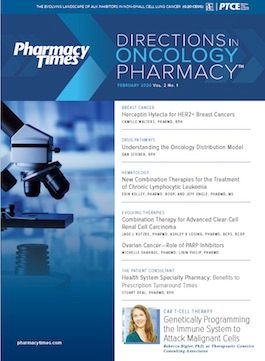Publication
Article
Pharmacy Practice in Focus: Oncology
Melanoma: Increasing Cases and Growing Treatment Possibilities
With cases of melanoma increasing more rapidly than those of other malignancies (especially in men), no conference on oncology pharmacy would be complete without a session covering this topic and its expansion of treatment options.
With cases of melanoma increasing more rapidly than those of other malignancies (especially in men), no conference on oncology pharmacy would be complete without a session covering this topic and its expansion of treatment options. That was the case at the 2019 Directions in Oncology Pharmacy™ conference.
Laura Alwan, PharmD, BCOP, oncology clinical pharmacist at University of Washington Medical Center and Seattle Cancer Care Alliance, gave participants a comprehensive overview of this cancer. It kills approximately 7200 Americans every year, although the death rate is falling. She noted that the median age at diagnosis is 63 years, and as most pharmacists are well aware, individuals who are Caucasian, have a personal or family history of melanoma, have been exposed to sun lamps and tanning beds, or have melanocytic nevi and atypical nevi are at highest risk.
Alwan spent some time covering the prognostic significance of mutations. Perhaps the most important of all the mutations is the BRAF mutation, and especially the BRAF V600E. This mutation is found in between 30% and 60% of all melanomas. For this reason, the BRAF inhibitors and MEK inhibitors are drugs of choice to treat BRAF-mutation positive melanoma. The NRAS mutation is the second most common of mutations and is associated with superficial spreading melanomas. These melanomas are highly aggressive and associated with shorter survival. Although there is no effective way to block mutant and RAS activity, researchers are currently investigating a number of therapies.
Since the 1970s, treatment paradigms for melanoma have changed and advanced considerably with the addition of several targeted small molecules. Alwan described the pivotal and confirmatory trials that supported approval and increasing use of newer drugs and biologics for melanoma.
The past few years have changed the landscape of adjuvant therapy for stage III node-positive melanoma. Previously, patients were treated with surgery and often drug therapy was not indicated. There are now roles for immunotherapy, including single-agent nivolumab and pembrolizumab as well as oral dabrafenib/trametinib for BRAF-positive stage III disease. Currently, there are no head-to-head studies to determine which therapy or strategy is most effective.
For first-line therapy of stage IV or metastatic disease, a plethora of therapies now show benefit including single-agent pembrolizumab and nivolumab in addition to combination immunotherapy with nivolumab and ipilimumab. Multiple BRAF/MEK oral combinations are also employed, including dabrafenib + trametinib, vemurafenib + cobimetinib, and encorafenib + binimetinib. One combination is not preferred over another based on efficacy at this time. Alwan shared an important difference between these oral agents and immunotherapy in that these agents have a shorter time to onset of response versus immunotherapy.
Unfortunately, melanoma can metastasize to the brain and often does. This is a very common site for therapeutic failure, and patients who have brain metastases tend to be excluded from clinical trials. Brain metastases are the cause of death in the majority of patients who die of melanoma-related disease. Once melanoma has metastasized to the brain, overall survival is generally around 5 months. Alwan reviewed the numerous therapies and their success rates and adverse reactions.
She shared what therapies are used for first-line treatment of metastatic or unresectable disease as well as subsequent lines of therapy after disease progression. She followed this with a practical comparison of BRAF and MEK inhibitors as well as checkpoint inhibitors that included administration, dosing, and adverse effects.
Alwan’s summary of appropriate methods to manage dermatologic adverse effects associated with immune checkpoint inhibitor (ipilimumab, nivolumab, pembrolizumab) therapy was particularly helpful, describing appropriate interventions starting with grade 1 and progressing to grade 4. At grade 1, patients need topical emollients and possibly topical corticosteroids. Although it should go without saying, patients should also avoid sun exposure. At grade 2, patients may need oral prednisone and should continue topical emollients, initiate oral antihistamines, and step up to medium- to high-potency topical corticosteroids. Clinicians should consider holding the immune checkpoint inhibitor. At grades 3 and 4, patients will need prednisone or methylprednisolone (oral at grade 3, intravenous at grade 4), tapering over at least 4 to 6 weeks. At grade 3, clinicians will hold the immune checkpoint inhibitor and request dermatology consult before resuming it. At grade 4, the likelihood is that the immune checkpoint inhibitor will not be restarted unless benefits outweigh risks.
Pharmacists have some very specific roles in treating a patient with melanoma. They need to collaborate closely with health care providers. They also need to make sure that patients understand the goals of therapy, the adverse effects that they can expect and those that would require immediate care, storage and disposal of their medications, and of course, appropriate ways to ensure complete adherence. She advocated for telephone follow-up to do adherence assessment because adherence can make the difference between life and death in this disease. Pharmacists are exceptionally skilled at symptom management, and they can also contribute to survivorship care for this population.







